Deep-Learning-Based Multi-Channel Satellite Precipitation Forecasting Enhanced by Cloud Phase Classification
Abstract
1. Introduction
2. Data
2.1. FY-4A Satellite
2.2. Himawari-8 Cloud Classification Products
2.3. Precipitation Data
2.4. Analysis of Cloud–Precipitation Relationships
3. Method
3.1. Model Architecture and Cloud Classification Product Integration
3.2. Experimental Plan Setup
- Input Data: FY-4A satellite infrared observations from bands 09 to 14;
- Input Data: FY-4A satellite infrared observations from bands 09 to 14 + DEM;
- Input Data: FY-4A satellite infrared observations from bands 09 to 14 + DEM + probability of precipitation matrix;
- Input Data: FY-4A satellite infrared observations from bands 09 to 14 + DEM + probability of precipitation matrix incorporating temporal information.
3.3. Experimental Evaluation Metrics
4. Evaluation of Precipitation Forecasting Performance
4.1. Performance Analysis of Four Precipitation Forecasting Plans
4.2. Spatial Distribution of Precipitation Forecast Metrics
4.3. Evaluation of Precipitation Forecast Accuracy Using Rain Gauges
5. Conclusions
6. Discussion
Author Contributions
Funding
Data Availability Statement
Acknowledgments
Conflicts of Interest
References
- Bi, K.; Xie, L.; Zhang, H.; Chen, X.; Gu, X.; Tian, Q. Accurate Medium-Range Global Weather Forecasting with 3D Neural Networks. Nature 2023, 619, 533–538. [Google Scholar] [CrossRef]
- Pan, X.; Lu, Y.; Zhao, K.; Huang, H.; Wang, M.; Chen, H. Improving Nowcasting of Convective Development by Incorporating Polarimetric Radar Variables Into a Deep-Learning Model. Geophys. Res. Lett. 2021, 48, e2021GL095302. [Google Scholar] [CrossRef]
- Sadeghi, M.; Nguyen, P.; Hsu, K.; Sorooshian, S. Improving near Real-Time Precipitation Estimation Using a U-Net Convolutional Neural Network and Geographical Information. Environ. Model. Softw. 2020, 134, 104856. [Google Scholar] [CrossRef]
- Mekonnen, K.; Melesse, A.M.; Woldesenbet, T.A. Spatial Evaluation of Satellite-Retrieved Extreme Rainfall Rates in the Upper Awash River Basin, Ethiopia. Atmos. Res. 2021, 249, 105297. [Google Scholar] [CrossRef]
- Gebremicael, T.G. Satellite-Based Rainfall Estimates Evaluation Using a Parsimonious Hydrological Model in the Complex Climate and Topography of the Nile River Catchments. Atmos. Res. 2022, 266, 105939. [Google Scholar] [CrossRef]
- Penteliuc, M.; Frincu, M. Prediction of Cloud Movement from Satellite Images Using Neural Networks. In Proceedings of the 2019 21st International Symposium on Symbolic and Numeric Algorithms for Scientific Computing (SYNASC), Timisoara, Romania, 4–7 September 2019; pp. 222–229. [Google Scholar]
- Chen, Y.; Huang, J.; Song, X.; Wen, H.; Song, H. Evaluation of the Impacts of Rain Gauge Density and Distribution on Gauge-Satellite Merged Precipitation Estimates. IEEE Trans. Geosci. Remote Sens. 2022, 60, 4100218. [Google Scholar] [CrossRef]
- Battaglia, A.; Kollias, P.; Dhillon, R.; Roy, R.; Tanelli, S.; Lamer, K.; Grecu, M.; Lebsock, M.; Watters, D.; Mroz, K.; et al. Spaceborne Cloud and Precipitation Radars: Status, Challenges, and Ways Forward. Rev. Geophys. 2020, 58, e2019RG000686. [Google Scholar] [CrossRef]
- Upadhyaya, S.A.; Kirstetter, P.; Kuligowski, R.J.; Searls, M. Towards Improved Precipitation Estimation with the GOES-16 Advanced Baseline Imager: Algorithm and Evaluation. Q. J. R. Meteorol. Soc. 2022, 148, 3406–3427. [Google Scholar] [CrossRef]
- Jiang, Y.; Gao, F.; Zhang, S.; Cheng, W.; Liu, C.; Wang, S. MCSPF-Net: A Precipitation Forecasting Method Using Multi-Channel Cloud Observations of FY-4A Satellite by 3D Convolution Neural Network. Remote Sens. 2023, 15, 4536. [Google Scholar] [CrossRef]
- Morrison, H.; Van Lier-Walqui, M.; Fridlind, A.M.; Grabowski, W.W.; Harrington, J.Y.; Hoose, C.; Korolev, A.; Kumjian, M.R.; Milbrandt, J.A.; Pawlowska, H.; et al. Confronting the Challenge of Modeling Cloud and Precipitation Microphysics. J. Adv. Model. Earth Syst. 2020, 12, e2019MS001689. [Google Scholar] [CrossRef]
- Berg, W.; L’Ecuyer, T.; Van Den Heever, S. Evidence for the Impact of Aerosols on the Onset and Microphysical Properties of Rainfall from a Combination of Satellite Observations and Cloud-resolving Model Simulations. J. Geophys. Res. Atmospheres 2008, 113, 2007JD009649. [Google Scholar] [CrossRef]
- Shen, X.; Wang, Y.; Zhang, N.; Li, X. Precipitation and Cloud Statistics in the Deep Tropical Convective Regime. J. Geophys. Res. Atmospheres 2010, 115, 2010JD014481. [Google Scholar] [CrossRef]
- Wang, C.; Tang, G.; Xiong, W.; Ma, Z.; Zhu, S. Infrared Precipitation Estimation Using Convolutional Neural Network for FengYun Satellites. J. Hydrol. 2021, 603, 127113. [Google Scholar] [CrossRef]
- Xue, M.; Hang, R.; Liu, Q.; Yuan, X.-T.; Lu, X. CNN-Based near-Real-Time Precipitation Estimation from Fengyun-2 Satellite over Xinjiang, China. Atmos. Res. 2021, 250, 105337. [Google Scholar] [CrossRef]
- Hayatbini, N.; Kong, B.; Hsu, K.; Nguyen, P.; Sorooshian, S.; Stephens, G.; Fowlkes, C.; Nemani, R. Conditional Generative Adversarial Networks (cGANs) for Near Real-Time Precipitation Estimation from Multispectral GOES-16 Satellite Imageries—PERSIANN-cGAN. Remote Sens. 2019, 11, 2193. [Google Scholar] [CrossRef]
- Sadeghi, M.; Asanjan, A.A.; Faridzad, M.; Nguyen, P.; Hsu, K.; Sorooshian, S.; Braithwaite, D. PERSIANN-CNN: Precipitation Estimation from Remotely Sensed Information Using Artificial Neural Networks–Convolutional Neural Networks. J. Hydrometeorol. 2019, 20, 2273–2289. [Google Scholar] [CrossRef]
- Hong, Y.; Hsu, K.-L.; Sorooshian, S.; Gao, X. Precipitation Estimation from Remotely Sensed Imagery Using an Artificial Neural Network Cloud Classification System. J. Appl. Meteorol. 2004, 43, 1834–1853. [Google Scholar] [CrossRef]
- Salahi, A.; Ashrafzadeh, A.; Vazifedoust, M. Remote Sensing-Based Precipitation Forecasting Using Cloud Optical Characteristics: Threshold Optimization and Evaluation in Northern and Western Iran. Nat. Hazards 2024, 120, 3661–3675. [Google Scholar] [CrossRef]
- Afzali Gorooh, V.; Kalia, S.; Nguyen, P.; Hsu, K.; Sorooshian, S.; Ganguly, S.; Nemani, R. Deep Neural Network Cloud-Type Classification (DeepCTC) Model and Its Application in Evaluating PERSIANN-CCS. Remote Sens. 2020, 12, 316. [Google Scholar] [CrossRef]
- Hong, J.; Mao, F.; Gong, W.; Gan, Y.; Zang, L.; Quan, J.; Chen, J. Assimilating Fengyun-4A Observations to Improve WRF-Chem PM2.5 Predictions in China. Atmos. Res. 2022, 265, 105878. [Google Scholar] [CrossRef]
- Zhang, P.; Lu, Q.; Hu, X.; Gu, S.; Yang, L.; Min, M.; Chen, L.; Xu, N.; Sun, L.; Bai, W.; et al. Latest Progress of the Chinese Meteorological Satellite Program and Core Data Processing Technologies. Adv. Atmos. Sci. 2019, 36, 1027–1045. [Google Scholar] [CrossRef]
- Hu, Y.; Zhang, Y.; Yan, L.; Li, X.-M.; Dou, C.; Jia, G.; Si, Y.; Zhang, L. Evaluation of the Radiometric Calibration of FY4A-AGRI Thermal Infrared Data Using Lake Qinghai. IEEE Trans. Geosci. Remote Sens. 2021, 59, 8040–8050. [Google Scholar] [CrossRef]
- Yang, J.; Zhang, Z.; Wei, C.; Lu, F.; Guo, Q. Introducing the New Generation of Chinese Geostationary Weather Satellites, Fengyun-4. Bull. Am. Meteorol. Soc. 2017, 98, 1637–1658. [Google Scholar] [CrossRef]
- Xian, D.; Zhang, P.; Gao, L.; Sun, R.; Zhang, H.; Jia, X. Fengyun Meteorological Satellite Products for Earth System Science Applications. Adv. Atmos. Sci. 2021, 38, 1267–1284. [Google Scholar] [CrossRef]
- Bessho, K.; Date, K.; Hayashi, M.; Ikeda, A.; Imai, T.; Inoue, H.; Kumagai, Y.; Miyakawa, T.; Murata, H.; Ohno, T.; et al. An Introduction to Himawari-8/9-Japan’s New-Generation Geostationary Meteorological Satellites. J. Meteorol. Soc. Jpn. Ser II 2016, 94, 151–183. [Google Scholar] [CrossRef]
- Letu, H.; Nagao, T.M.; Nakajima, T.Y.; Riedi, J.; Ishimoto, H.; Baran, A.J.; Shang, H.; Sekiguchi, M.; Kikuchi, M. Ice Cloud Properties From Himawari-8/AHI Next-Generation Geostationary Satellite: Capability of the AHI to Monitor the DC Cloud Generation Process. IEEE Trans. Geosci. Remote Sens. 2019, 57, 3229–3239. [Google Scholar] [CrossRef]
- Nie, L.; Chen, Y.; Zhang, D. All-Day Cloud Property and Occurrence Probability Dataset Based on Satellite Remote Sensing Data. Sci. Data 2025, 12, 387. [Google Scholar] [CrossRef]
- Hahn, C.J.; Rossow, W.B.; Warren, S.G. ISCCP Cloud Properties Associated with Standard Cloud Types Identified in Individual Surface Observations. J. Clim. 2001, 14, 11–28. [Google Scholar] [CrossRef]
- Huffman, G.J.; Bolvin, D.T.; Braithwaite, D.; Hsu, K.; Joyce, R.; Kidd, C.; Sorooshian, S.; Xie, P. Developing the Integrated Multi-Satellite Retrievals for GPM (IMERG). In Proceedings of the EGU General Assembly Conference Abstracts; EGU, Vienna, Austria, 22–27 April 2012; Volume 6921. [Google Scholar]
- Tang, G.; Zeng, Z.; Long, D.; Guo, X.; Yong, B.; Zhang, W.; Hong, Y. Statistical and Hydrological Comparisons between TRMM and GPM Level-3 Products over a Midlatitude Basin: Is Day-1 IMERG a Good Successor for TMPA 3B42V7? J. Hydrometeorol. 2016, 17, 121–137. [Google Scholar] [CrossRef]
- Hou, A.Y.; Kakar, R.K.; Neeck, S.; Azarbarzin, A.A.; Kummerow, C.D.; Kojima, M.; Oki, R.; Nakamura, K.; Iguchi, T. The Global Precipitation Measurement Mission. Bull. Am. Meteorol. Soc. 2014, 95, 701–722. [Google Scholar] [CrossRef]
- Liu, Z.; Ostrenga, D.; Vollmer, B.; Deshong, B.; Macritchie, K.; Greene, M.; Kempler, S. Global Precipitation Measurement Mission Products and Services at the NASA GES DISC. Bull. Am. Meteorol. Soc. 2017, 98, 437–444. [Google Scholar] [CrossRef] [PubMed]
- Maggioni, V.; Meyers, P.C.; Robinson, M.D. A Review of Merged High-Resolution Satellite Precipitation Product Accuracy during the Tropical Rainfall Measuring Mission (TRMM) Era. J. Hydrometeorol. 2016, 17, 1101–1117. [Google Scholar] [CrossRef]
- Foelsche, U.; Kirchengast, G.; Fuchsberger, J.; Tan, J.; Petersen, W.A. Evaluation of GPM IMERG Early, Late, and Final Rainfall Estimates Using WegenerNet Gauge Data in Southeastern Austria. Hydrol. Earth Syst. Sci. 2017, 21, 6559–6572. [Google Scholar] [CrossRef]
- Satgé, F.; Hussain, Y.; Bonnet, M.-P.; Hussain, B.; Martinez-Carvajal, H.; Akhter, G.; Uagoda, R. Benefits of the Successive GPM Based Satellite Precipitation Estimates IMERG–V03, –V04, –V05 and GSMaP–V06, –V07 Over Diverse Geomorphic and Meteorological Regions of Pakistan. Remote Sens. 2018, 10, 1373. [Google Scholar] [CrossRef]
- Pradhan, R.K.; Markonis, Y.; Vargas Godoy, M.R.; Villalba-Pradas, A.; Andreadis, K.M.; Nikolopoulos, E.I.; Papalexiou, S.M.; Rahim, A.; Tapiador, F.J.; Hanel, M. Review of GPM IMERG Performance: A Global Perspective. Remote Sens. Environ. 2022, 268, 112754. [Google Scholar] [CrossRef]
- Liu, Z. Comparison of Integrated Multisatellite Retrievals for GPM (IMERG) and TRMM Multisatellite Precipitation Analysis (TMPA) Monthly Precipitation Products: Initial Results. J. Hydrometeorol. 2016, 17, 777–790. [Google Scholar] [CrossRef]
- Sun, Q.; Miao, C.; Duan, Q.; Ashouri, H.; Sorooshian, S.; Hsu, K. A Review of Global Precipitation Data Sets: Data Sources, Estimation, and Intercomparisons. Rev. Geophys. 2018, 56, 79–107. [Google Scholar] [CrossRef]
- Moazami, S.; Najafi, M.R. A Comprehensive Evaluation of GPM-IMERG V06 and MRMS with Hourly Ground-Based Precipitation Observations across Canada. J. Hydrol. 2021, 594, 125929. [Google Scholar] [CrossRef]
- Anjum, M.N.; Ding, Y.; Shangguan, D.; Ahmad, I.; Ijaz, M.W.; Farid, H.U.; Yagoub, Y.E.; Zaman, M.; Adnan, M. Performance Evaluation of Latest Integrated Multi-Satellite Retrievals for Global Precipitation Measurement (IMERG) over the Northern Highlands of Pakistan. Atmos. Res. 2018, 205, 134–146. [Google Scholar] [CrossRef]
- Huang, C.; Hu, J.; Chen, S.; Zhang, A.; Liang, Z.; Tong, X.; Xiao, L.; Min, C.; Zhang, Z. How Well Can IMERG Products Capture Typhoon Extreme Precipitation Events over Southern China? Remote Sens. 2019, 11, 70. [Google Scholar] [CrossRef]
- Xu, B.; Xie, P.; Xu, M.; Jiang, L.; Shi, C.; You, R. A Validation of Passive Microwave Rain-Rate Retrievals from the Chinese FengYun-3B Satellite. J. Hydrometeorol. 2015, 16, 1886–1905. [Google Scholar] [CrossRef]
- Ren, Z.; Zhao, P.; Zhang, Q.; Zhang, Z.; Cao, L.; Yang, L.; Zou, F.; Zhao, Y.; Zhao, H.; Chen, Z. Quality control procedures for hourly precipitation data from automatic weather stations in China. Meteorol. Mon. 2010, 36, 123–132. (In Chinese) [Google Scholar]
- Ronneberger, O.; Fischer, P.; Brox, T. U-Net: Convolutional Networks for Biomedical Image Segmentation. In Medical Image Computing and Computer-Assisted Intervention—MICCAI 2015; Navab, N., Hornegger, J., Wells, W.M., Frangi, A.F., Eds.; Lecture Notes in Computer Science; Springer International Publishing: Cham, Switzerland, 2015; Volume 9351, pp. 234–241. ISBN 978-3-319-24573-7. [Google Scholar]
- Xie, S.; Girshick, R.; Dollár, P.; Tu, Z.; He, K. Aggregated Residual Transformations for Deep Neural Networks. arXiv 2017, arXiv:1611.05431. [Google Scholar] [CrossRef]
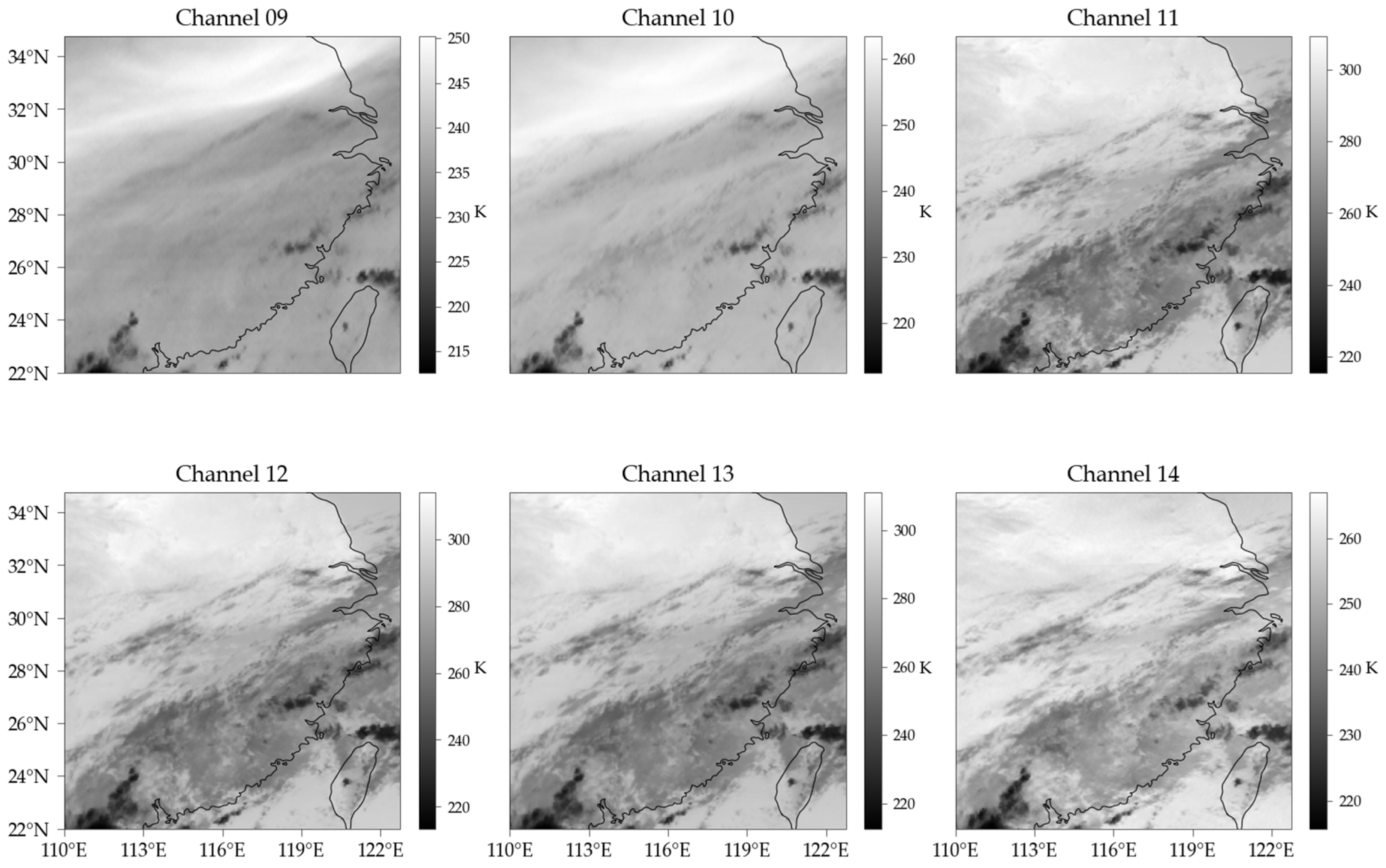
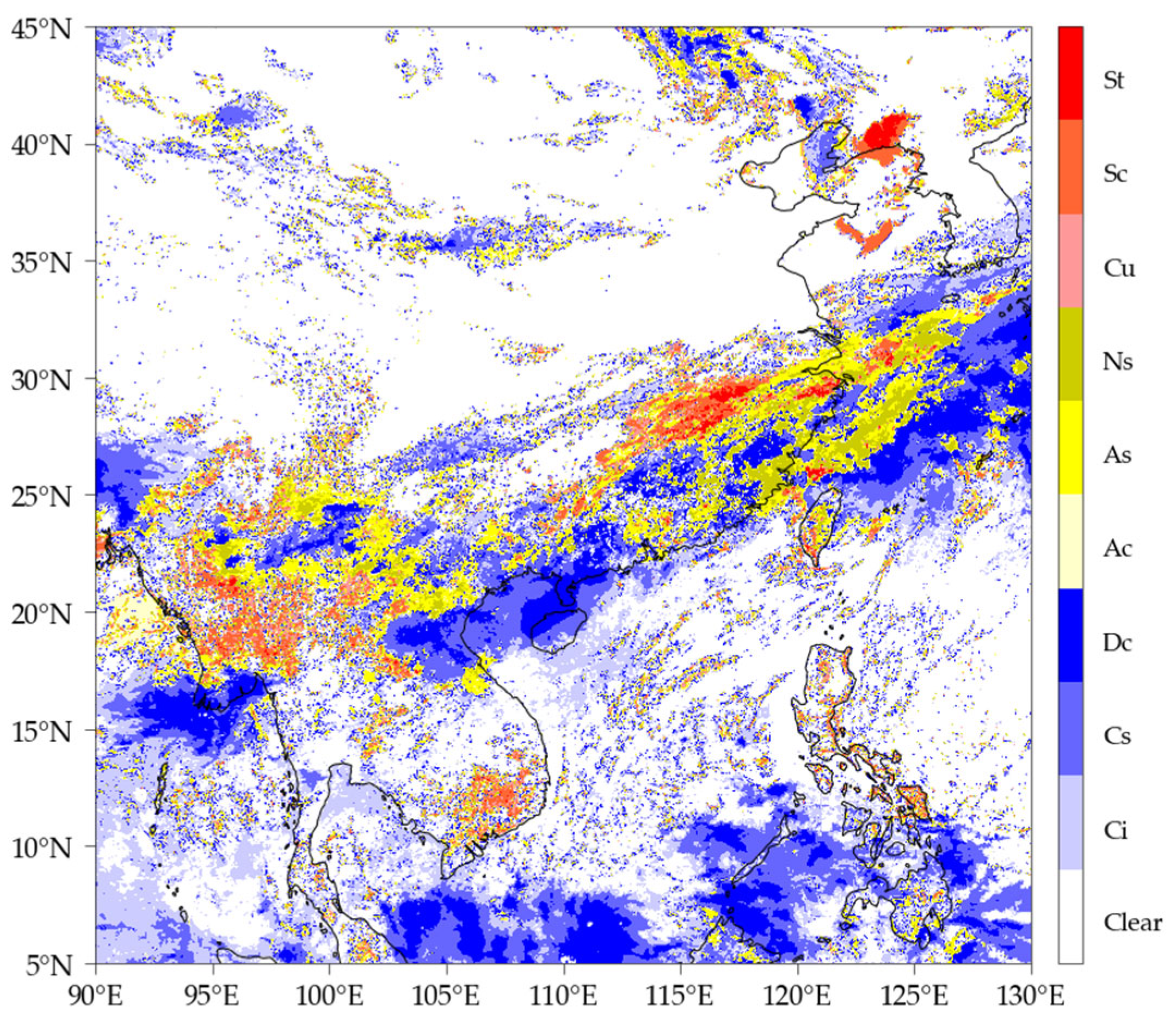
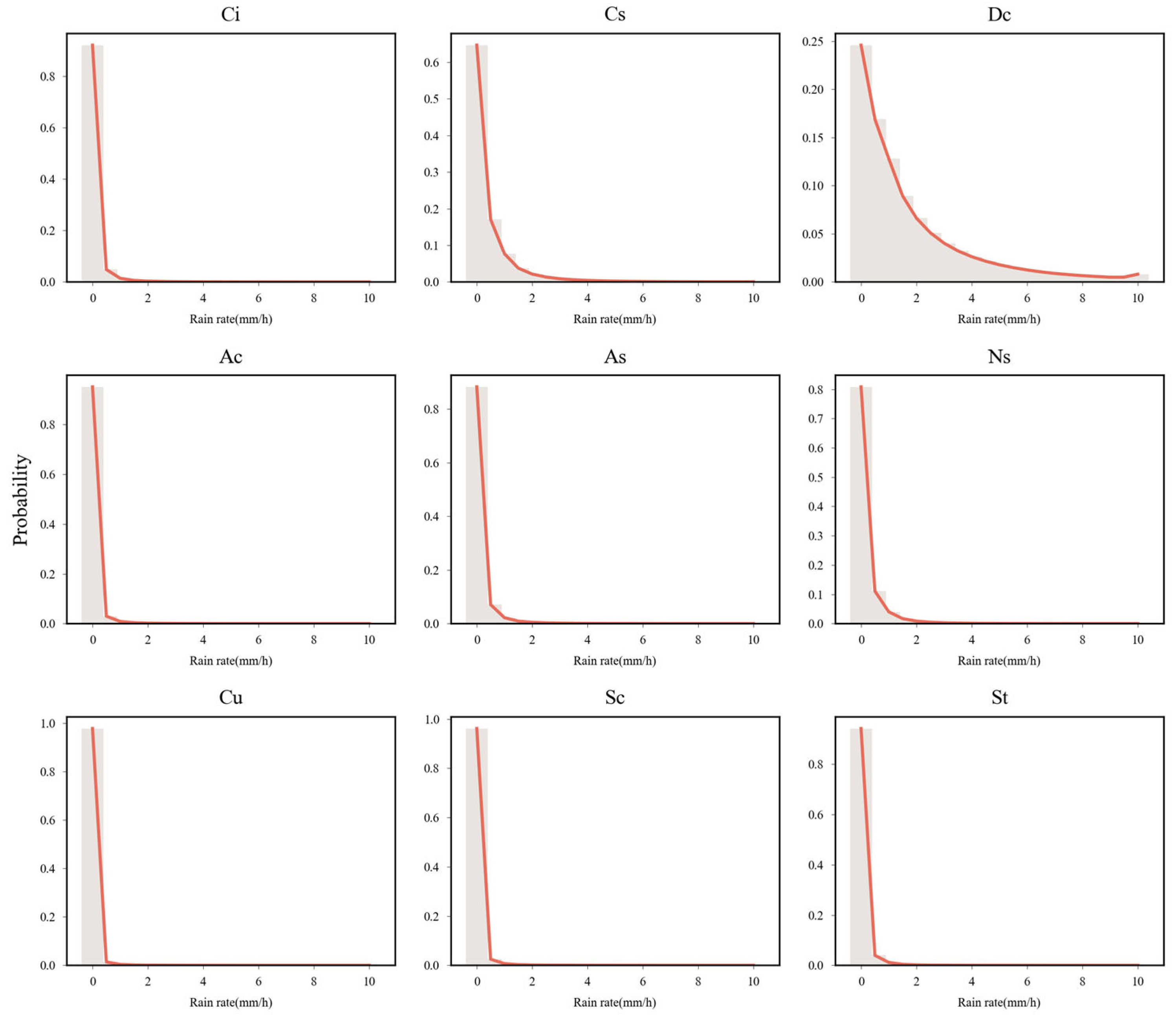

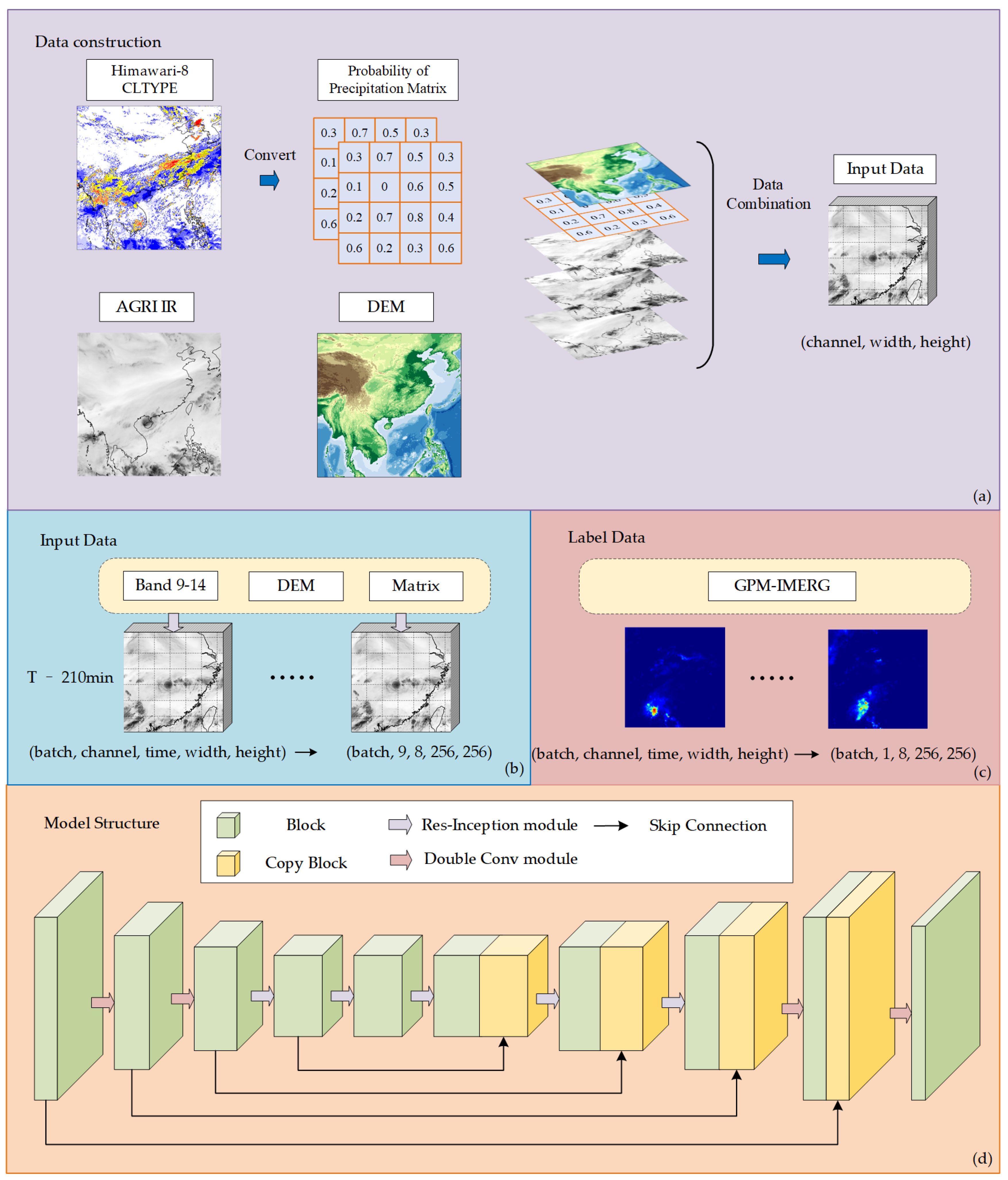

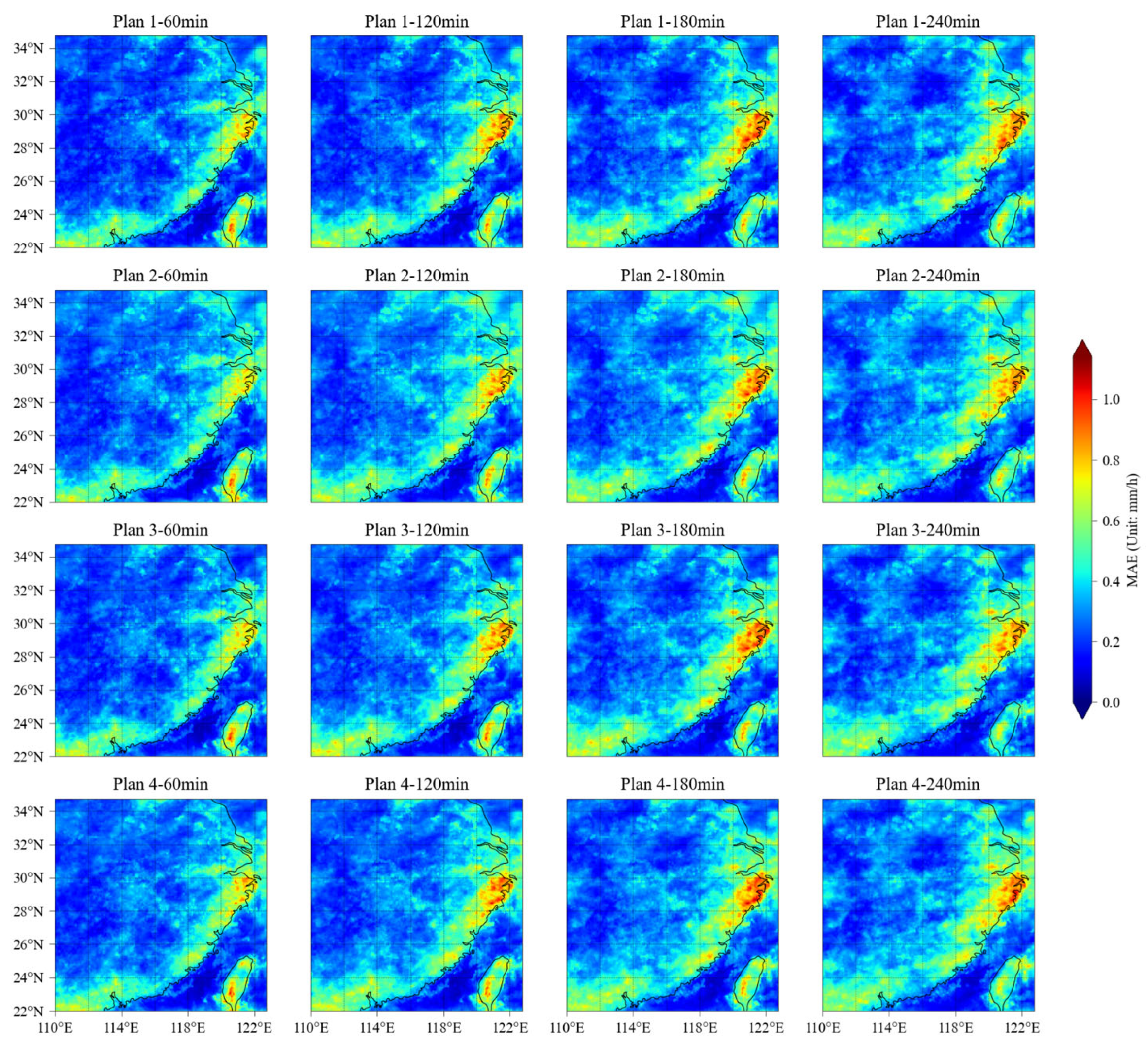

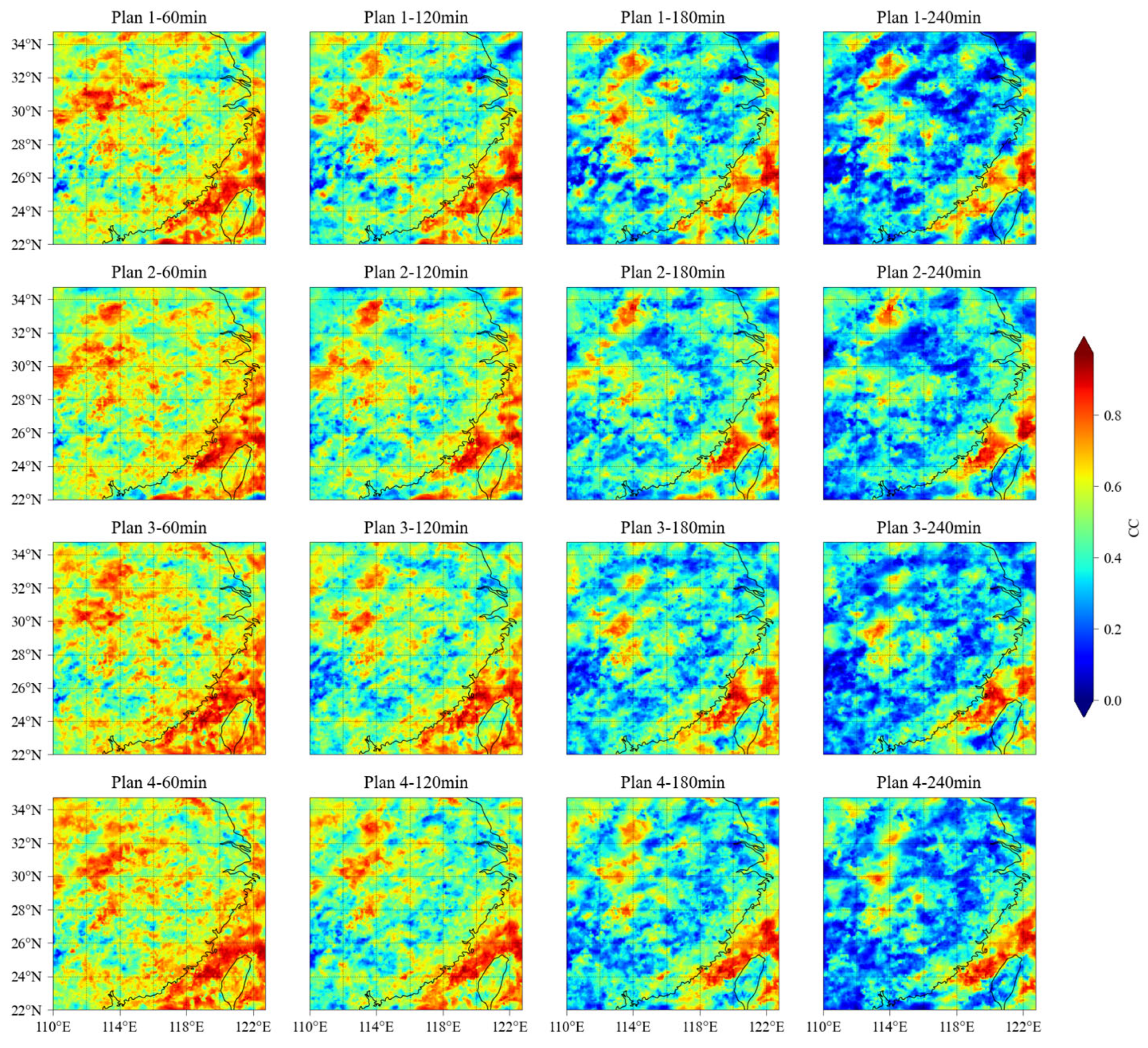

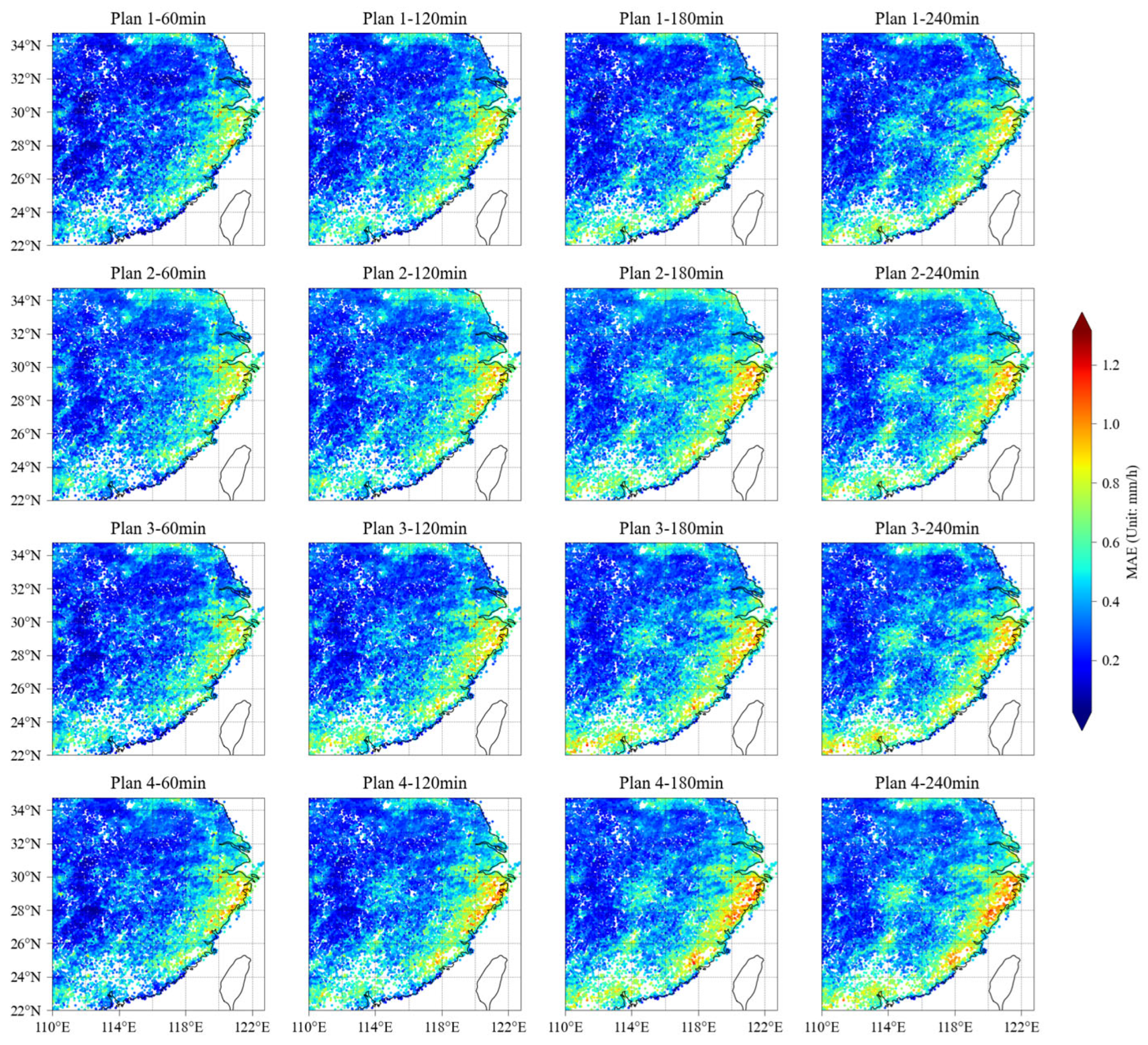
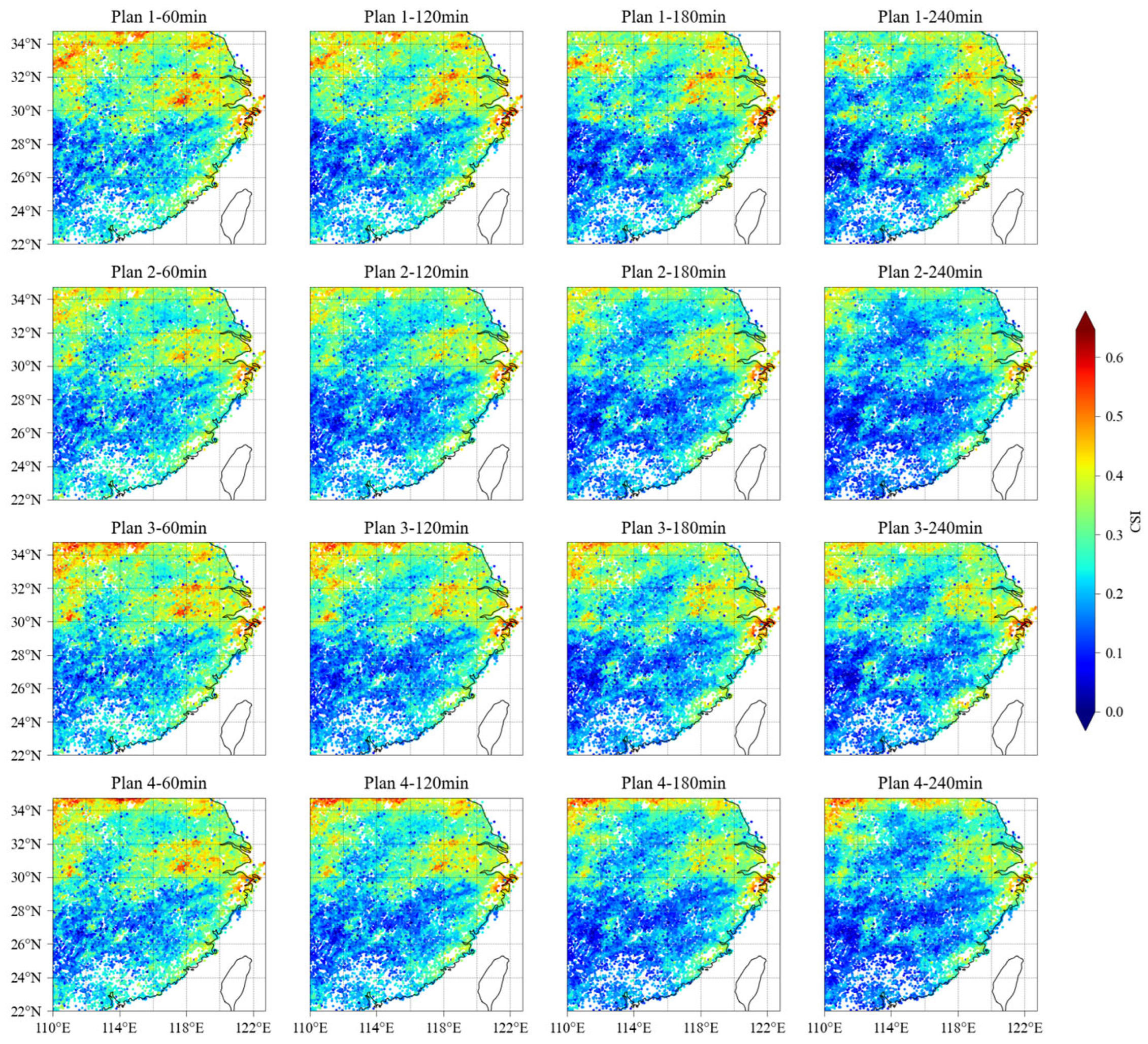
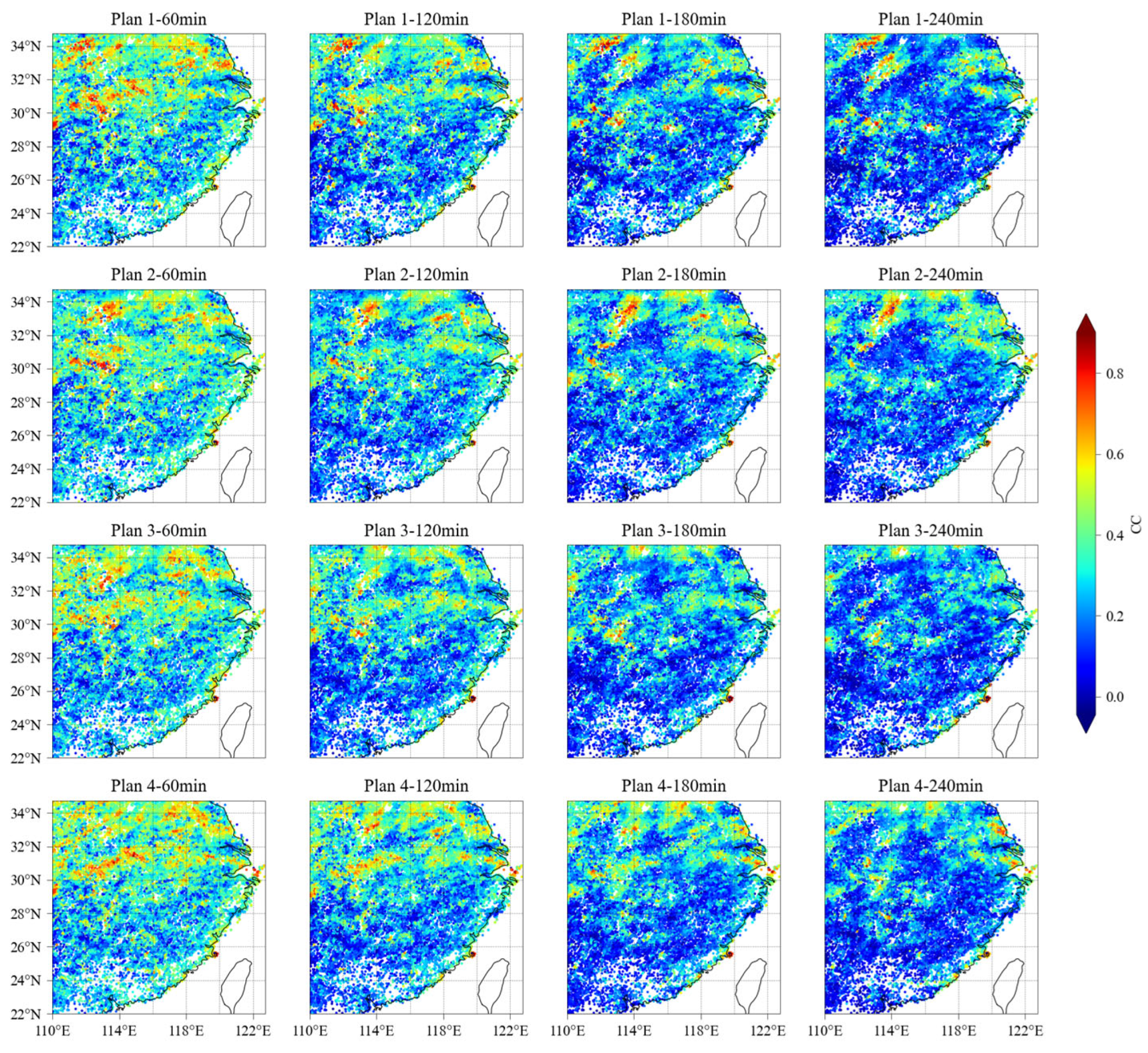

| Metric | Plan 1 | Plan 2 | Plan 3 | Plan 4 |
|---|---|---|---|---|
| MSE | 2.161 | 2.121 | 2.098 | 2.097 |
| MAE | 0.335 | 0.358 | 0.340 | 0.350 |
| CC | 0.395 | 0.421 | 0.410 | 0.418 |
| POD | 0.541 | 0.679 | 0.644 | 0.681 |
| FAR | 0.370 | 0.453 | 0.412 | 0.437 |
| CSI | 0.410 | 0.431 | 0.442 | 0.443 |
| Threshold (mm/h) | Plan 1 | Plan 2 | Plan 3 | Plan 4 |
|---|---|---|---|---|
| 0.1 | 0.271 | 0.245 | 0.265 | 0.254 |
| 1 | 0.175 | 0.183 | 0.185 | 0.191 |
| 2 | 0.115 | 0.122 | 0.114 | 0.126 |
| 3 | 0.072 | 0.078 | 0.068 | 0.080 |
| 5 | 0.021 | 0.032 | 0.024 | 0.031 |
Disclaimer/Publisher’s Note: The statements, opinions and data contained in all publications are solely those of the individual author(s) and contributor(s) and not of MDPI and/or the editor(s). MDPI and/or the editor(s) disclaim responsibility for any injury to people or property resulting from any ideas, methods, instructions or products referred to in the content. |
© 2025 by the authors. Licensee MDPI, Basel, Switzerland. This article is an open access article distributed under the terms and conditions of the Creative Commons Attribution (CC BY) license (https://creativecommons.org/licenses/by/4.0/).
Share and Cite
Jiang, Y.; Cheng, W.; Wang, S.; Bian, S.; Sun, J.; Li, Y.; Liu, J. Deep-Learning-Based Multi-Channel Satellite Precipitation Forecasting Enhanced by Cloud Phase Classification. Remote Sens. 2025, 17, 2853. https://doi.org/10.3390/rs17162853
Jiang Y, Cheng W, Wang S, Bian S, Sun J, Li Y, Liu J. Deep-Learning-Based Multi-Channel Satellite Precipitation Forecasting Enhanced by Cloud Phase Classification. Remote Sensing. 2025; 17(16):2853. https://doi.org/10.3390/rs17162853
Chicago/Turabian StyleJiang, Yuhang, Wei Cheng, Shudong Wang, Shuangshuang Bian, Jingzhe Sun, Yayun Li, and Juanjuan Liu. 2025. "Deep-Learning-Based Multi-Channel Satellite Precipitation Forecasting Enhanced by Cloud Phase Classification" Remote Sensing 17, no. 16: 2853. https://doi.org/10.3390/rs17162853
APA StyleJiang, Y., Cheng, W., Wang, S., Bian, S., Sun, J., Li, Y., & Liu, J. (2025). Deep-Learning-Based Multi-Channel Satellite Precipitation Forecasting Enhanced by Cloud Phase Classification. Remote Sensing, 17(16), 2853. https://doi.org/10.3390/rs17162853





